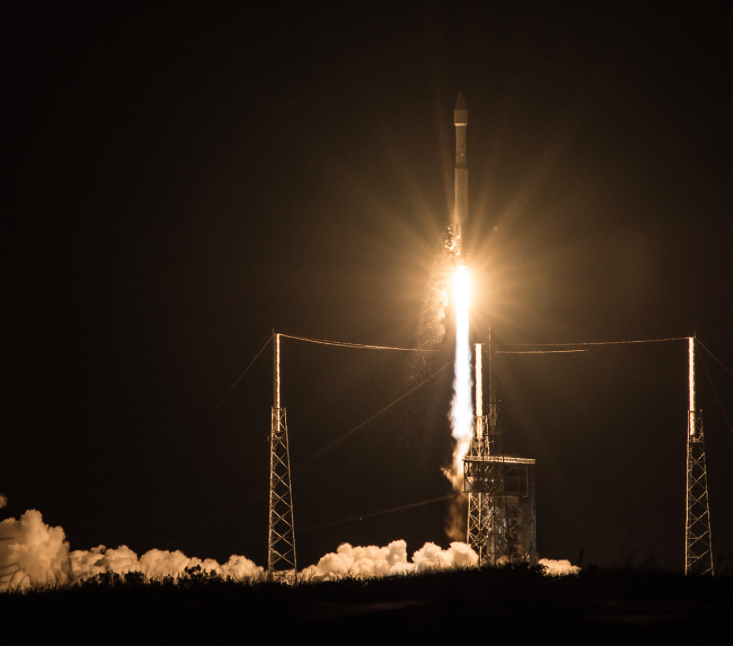The mission is designed for early-warning missile detection and Aerojet Rocketdyne provided the RL10C-1 upper-stage engine, six helium pressurization tanks, and 12 Centaur upper-stage Reaction Control System thrusters (RCS); and 18 monopropellant hydrazine thrusters on the GEO Flight 3 satellite.

Aerojet Rocketdyne created the propulsion systems on the Atlas V.
SACRAMENTO, California, January 20, 2017 (GLOBE NEWSWIRE) — Aerojet Rocketdyne, Inc., a subsidiary of Aerojet Rocketdyne Holdings, Inc. (NYSE:AJRD), began the New Year by successfully supporting the launch of the Lockheed Martin-built third Space Based Infrared System (SBIRS) Geosynchronous satellite (GEO Flight 3) for the U.S. Air Force. The mission, which is designed for early-warning missile detection, was launched from Cape Canaveral Air Force Station in Florida aboard a United Launch Alliance Atlas V rocket. Aerojet Rocketdyne propulsion systems on the Atlas V include the RL10C-1 upper-stage engine, six helium pressurization tanks, and 12 Centaur upper-stage Reaction Control System thrusters (RCS); also, Aerojet Rocketdyne provided 18 monopropellant hydrazine thrusters on the GEO Flight 3 satellite.
“It’s an honor to know our propulsion systems helped place another critical satellite into orbit in support of our nation’s defense – one that will provide key capabilities in the areas of missile warning, missile defense, technical intelligence and battlespace awareness,” said Aerojet Rocketdyne CEO and President Eileen Drake.
Aerojet Rocketdyne's RL10C-1 upper-stage engine ignited after separation of the first stage to place the payload into orbit, helped by the Centaur RCS thrusters and pressurization tanks. The RL10C-1 delivers 22,890 pounds of thrust to power the Atlas V upper stage, using cryogenic liquid hydrogen and liquid oxygen propellants.
The RL10C-1 was developed from the RL10 family of upper-stage engines, which have accumulated one of the most impressive track records of accomplishments in the history of space propulsion. More than 475 RL10 engines have supported launches over the last 50 years, playing a vital role in placing military, government and commercial satellites into orbit, and powering scientific space-probes on every interplanetary mission in our solar system.
Aerojet Rocketdyne provides 12 MR-106 monopropellant hydrazine thrusters in four modules on the Atlas V Centaur upper-stage which provide roll, pitch and yaw control, as well as settling burns. The GEO Flight 3 satellite has 18 monopropellant hydrazine thrusters onboard: 12 MR-103G 0.2-lbf thrusters and six MR-106L 5-lbf thrusters. Once separated from the launch vehicle, the 18 thrusters on the GEO Flight 3 satellite provide stationkeeping, three-axis control and de-spinning of the reaction wheels throughout the mission. They also provide attitude control during orbit-raising, as well as the impulse needed for final decommissioning of the satellite.
ARDÉ, a subsidiary of Aerojet Rocketdyne based in New Jersey, provided the pressure vessels on the first and second stages of the launch vehicle.
Lockheed Martin is the prime contractor for SBIRS, which includes a combination of satellites in Geosynchronous Earth Orbit, hosted payloads in Highly Elliptical Orbit, and ground hardware and software. The data provided by SBIRS is designed to enhance the U.S. military’s ability to detect missile launches, support ballistic missile defense, expand technical intelligence gathering and bolster battlespace awareness.
Aerojet Rocketdyne is an innovative company delivering solutions that create value for its customers in the aerospace and defense markets. The company is a world-recognized aerospace and defense leader that provides propulsion and energetics to the space, missile defense and strategic systems, tactical systems and armaments areas, in support of domestic and international markets.

